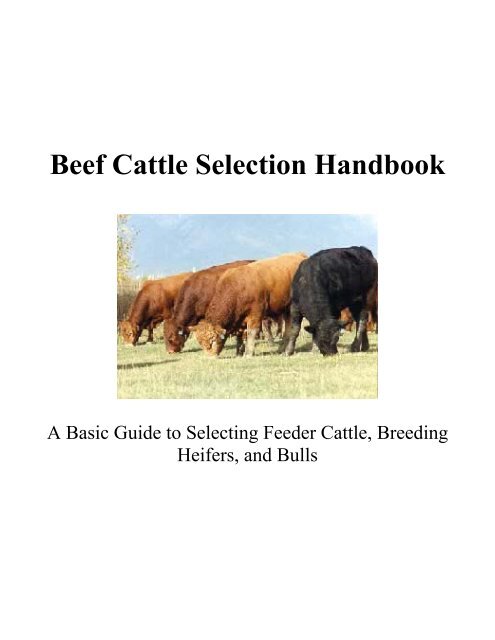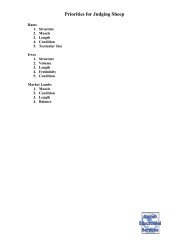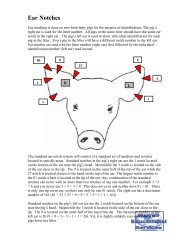Beef Cattle Selection Handbook - The Judging Connection .com
Beef Cattle Selection Handbook - The Judging Connection .com
Beef Cattle Selection Handbook - The Judging Connection .com
You also want an ePaper? Increase the reach of your titles
YUMPU automatically turns print PDFs into web optimized ePapers that Google loves.
<strong>Beef</strong> <strong>Cattle</strong> <strong>Selection</strong> <strong>Handbook</strong><br />
A Basic Guide to Selecting Feeder <strong>Cattle</strong>, Breeding<br />
Heifers, and Bulls
Where to Begin…<br />
What are your goals?<br />
What type of animal will help you achieve these goals?<br />
Age?<br />
Sex?<br />
Weight?<br />
Breed(s)?<br />
What limitations do you face?
<strong>Cattle</strong> Evaluation in General<br />
Parts:<br />
Pin Bone<br />
Hock<br />
Tailhead<br />
Hip Bone<br />
(Hooks)<br />
Rump Loin Back<br />
Round<br />
(Quarter)<br />
Stifle<br />
Flank<br />
Pastern<br />
Side<br />
(Ribs)<br />
Forearm<br />
Neck<br />
Shoulder<br />
Knee<br />
Poll<br />
Brisket<br />
Cannon Bone
Muscle<br />
LOIN (TOP)<br />
STIFLE<br />
WIDTH OF BASE<br />
FOREARM
Fat (Condition)<br />
TAILHEAD LOIN (TOP)<br />
RIBS<br />
FLANK<br />
WIDTH OF BASE<br />
BRISKET
Volume and Capacity<br />
LENGTH OF<br />
DEPTH<br />
OF<br />
RIB<br />
SHAPE
Structural Correctness<br />
LEVEL DESIGN<br />
-Desirable<br />
slope to shoulder and pasterns<br />
-All four legs set “at the corners”<br />
-Toes are pointed forward, hocks are<br />
square, not in or bowed out<br />
-<strong>The</strong> stride is long, smooth, and the front track should be filled by<br />
the back track
Evaluating Feeder <strong>Cattle</strong><br />
Phenotypic<br />
Priorities<br />
Muscle<br />
Condition<br />
(fatness vs. trimness)<br />
Capacity<br />
and Frame Size<br />
Structural<br />
Correctness<br />
Performance<br />
Traits<br />
Weight per Day of Age<br />
Feed<br />
Efficiency
Evaluating Breeding Heifers<br />
Structural Correctness<br />
Volume<br />
and Capacity<br />
Balance<br />
and Femininity<br />
Condition<br />
and Udder Development<br />
Muscle<br />
EPDs
Evaluating Bulls<br />
Structural Correctness<br />
Muscle<br />
Balance<br />
Capacity and Condition<br />
Testicular Size and Masculinity<br />
EPDs
Expected Progeny Differences<br />
Definition: “the differences in performance expected from the offspring of one individual <strong>com</strong>pared to<br />
the offspring of another individual, within the same breed”<br />
Ensminger and Perry, 1997<br />
-Prediction of how the offspring will perform, NOT the individual<br />
-Largest values are not always best: environment and goals determine desirable trait values<br />
-Accuracy is important; heritability is a factor<br />
-Not <strong>com</strong>parable between breeds, conversions are available<br />
-Utilize breed averages to determine if individual sires are acceptable, or to <strong>com</strong>pare sires of the<br />
same breed<br />
Common traits<br />
BW=Birth Weight<br />
WW=Weaning Weight<br />
YW=Yearling Weight<br />
MA, MM=Milking Ability, Maternal Milk<br />
TM=Total Maternal<br />
SC=Scrotal Circumference<br />
Others (not all breeds)<br />
CE=Calving ease<br />
GL=Gestation length<br />
STAY=Stayability<br />
DOC=Docility<br />
REA=Rib eye area<br />
MS, MARB, IMF=Marbling Score, Marbling, Intramuscular fat<br />
BF, BFT=Backfat, backfat thickness<br />
HCW=Hot carcass weight
Breed Averages<br />
Current Sires<br />
Angus<br />
BW WW<br />
EPDs:<br />
YW MA SC<br />
2.7 34 64 17 0.14<br />
Red Angus<br />
BW WW<br />
EPDs:<br />
YW MA SC<br />
0.7 28 49 14<br />
Charolais<br />
BW WW<br />
EPDs:<br />
YW MA SC<br />
1.7 15 25 9<br />
Gelbvieh<br />
BW WW<br />
EPDs:<br />
YW MA SC<br />
2.0 37 67 19 0.3<br />
Hereford<br />
BW WW<br />
EPDs:<br />
YW MA SC<br />
3.9 35 60 13 0.5<br />
Limousin<br />
BW WW<br />
EPDs:<br />
YW MA SC<br />
1.5 12.8 24 4 0.1<br />
Simmental<br />
BW WW<br />
EPDs:<br />
YW MA SC<br />
2.8 34.3 57.1 5.9
Practice Evaluations<br />
Angus Heifers with Performance Data<br />
Rank these heifers as replacements in a purebred Angus herd which primarily sells<br />
maternally oriented sires to <strong>com</strong>mercial cattlemen as well as other seedstock producer’s.<br />
Feed and labor are limiting factors on your operation as well as your customer’s ranches.<br />
1<br />
2<br />
3<br />
4<br />
BEPD: +1.3<br />
WEPD: +25.0<br />
YEPD: +40.0<br />
MEPD: +10.1<br />
BEPD: +0.3<br />
WEPD: +19.0<br />
YEPD: +28.0<br />
MEPD: +5.2<br />
BEPD: +3.2<br />
WEPD: +27.0<br />
YEPD: +48.0<br />
MEPD: +7.1<br />
BEPD: +2.6<br />
WEPD: +23.0<br />
YEPD: +38.7<br />
MEPD: +11
Feeder Steers<br />
Your job is to give advice to a local feedlot owner who has just started his business. He has four steers<br />
for you to look at, and he has some questions once you have seen the cattle. His goal is to market<br />
steers at 1250-1350 pounds, have the steers grade at least high Select, and yield grades 3 or lower.<br />
<strong>The</strong>se steers will be sent to slaughter in 70 days. Please answer his questions.<br />
Steer 1 940 pounds<br />
Steer 2 975 pounds
Steer 3 910 pounds<br />
Steer 4 990 pounds<br />
4
Questions:<br />
Which steer will likely have the largest rib eye area?<br />
Which steer will have the highest numerical yield grade?<br />
Which steer will be the highest cutability?<br />
Which steer is the poorest balanced, least structurally correct?<br />
Which steer do you think will make the most money?<br />
AI Bulls<br />
You currently own 5 purebred Charolais heifers. You now must choose a bull to breed your heifers to,<br />
and you’ve narrowed it down to five. It is up to you to pick out one bull for all heifers that will<br />
produce the kind of calves you want. You can use any breed, and you have searched the resources<br />
given to you at the end of this packet to find out how to <strong>com</strong>pare across breeds. Your heifers are<br />
muscular and structurally correct, but don’t have as much capacity as you would like. You’ve decided<br />
to sell the bull calves as show steers in the fall, and the heifers will be kept as replacements. Select the<br />
AI bull that you would like to use. All semen units cost the same.<br />
Your average heifer EPDs<br />
BW WW YW MA SC<br />
3.4 15 30 5 .11<br />
Red Angus<br />
EPDs:<br />
BW WW YW MA SC<br />
1.2 30 55 10 .01
Simmental<br />
EPDs:<br />
BW WW YW MA SC<br />
3.7 38 65 7.0 .06<br />
Gelbvieh<br />
EPDs:<br />
BW WW YW MA SC<br />
1.9 34 55 18 .3
Polled Hereford<br />
EPDs:<br />
BW WW YW MA SC<br />
5.0 45 78 13 0.5<br />
Angus<br />
EPDs:<br />
BW WW YW MA SC<br />
1.9 39 81 31 0.39
Keep/Cull Limousin Heifers<br />
You are a rancher in eastern Colorado looking to purchase four replacement females from a purebred<br />
limousin operation. <strong>The</strong>se heifers will be bred to an Angus bull. You have had problems with your<br />
purebred Angus cattle not being muscular enough, so this is why you chose to bring in a continental<br />
breed. All male progeny will be castrated, fed out, and ownership will be retained through the feedlot.<br />
<strong>The</strong>se cattle will be sold on a grid that pays a premium for Low Choice or better, YG 1 & 2 carcasses.<br />
<strong>The</strong> top 1/3 of the F1 female progeny will be kept as replacements, the rest will be fed out like the<br />
steers. Where you are located, the pastures and feed availability are good, but some years vary, and<br />
you predict that you can maintain 1200-pound cows with the feed resources. Labor is adequate at<br />
calving. Your goals as a producer are structurally correct, muscular cattle that feed easy and maintain<br />
their condition, as well as meeting the target for the carcass grid. Please select four heifers that you<br />
feel will meet your goals most adequately.<br />
Note what traits you think are important:<br />
#1<br />
EPDs:<br />
BW WW YW MA SC<br />
0.3 14 30 8 .2
#2<br />
#3<br />
EPDs:<br />
BW WW YW MA SC<br />
3.4 25 40 6 .12<br />
EPDs:<br />
BW WW YW MA SC<br />
2.5 28 49 12 .33
#4<br />
#5<br />
EPDs:<br />
BW WW YW MA SC<br />
1.2 14 26 6 .2<br />
EPDs:<br />
BW WW YW MA SC<br />
2.5 18 32 12 .22
#6<br />
#7<br />
EPDs:<br />
BW WW YW MA SC<br />
1.0 12 22 6 .4<br />
EPDs:<br />
BW WW YW MA SC<br />
2.0 17 30 3 .2
#8<br />
EPDs:<br />
BW WW YW MA SC<br />
3.1 22 43 7 .2<br />
Limousin Female Breed Averages<br />
BW WW<br />
EPDs:<br />
YW MA SC<br />
1.2 14 26 6 .2<br />
Keep: ____-____-____-____ Cull: ____-____-____-____
Useful Web Resources<br />
www.beefimprovement.org<br />
www.ca.uky.edu/agripedia/agmania/livestock<br />
www.marc.usda.gov<br />
www.ansci.okstate.eud/breeds/cattle<br />
www.animal.ufl.edu/youth/resources/Evaluation/Teaching/index.htm<br />
www.absglobal.<strong>com</strong>





